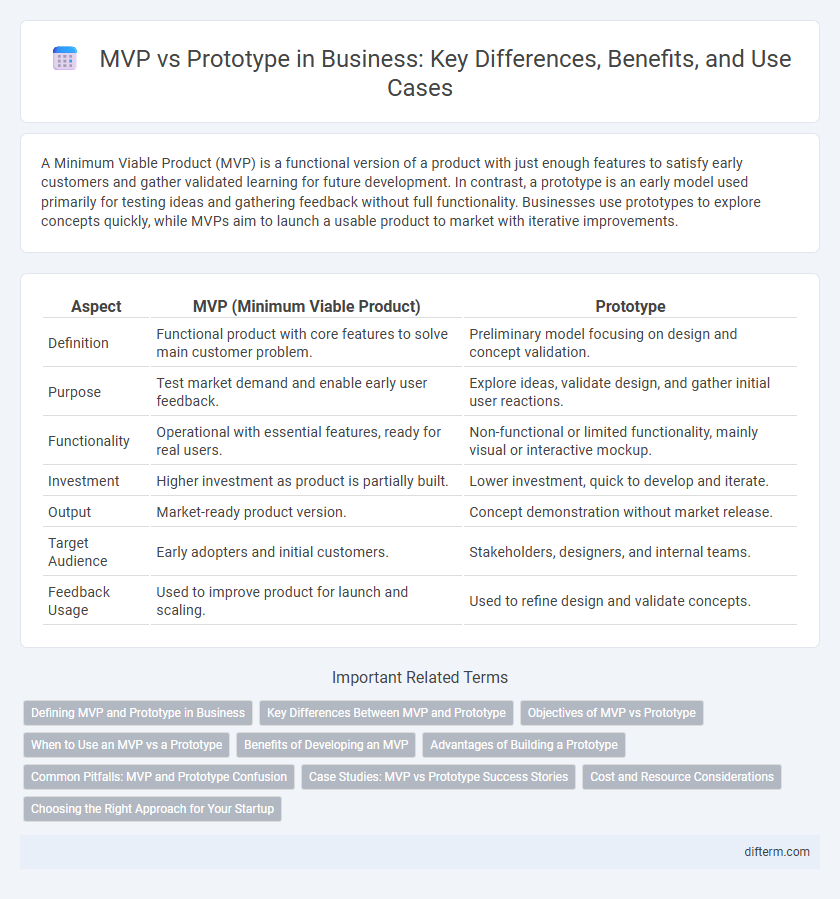A Minimum Viable Product (MVP) is a functional version of a product with just enough features to satisfy early customers and gather validated learning for future development. In contrast, a prototype is an early model used primarily for testing ideas and gathering feedback without full functionality. Businesses use prototypes to explore concepts quickly, while MVPs aim to launch a usable product to market with iterative improvements.
Table of Comparison
| Aspect | MVP (Minimum Viable Product) | Prototype |
|---|---|---|
| Definition | Functional product with core features to solve main customer problem. | Preliminary model focusing on design and concept validation. |
| Purpose | Test market demand and enable early user feedback. | Explore ideas, validate design, and gather initial user reactions. |
| Functionality | Operational with essential features, ready for real users. | Non-functional or limited functionality, mainly visual or interactive mockup. |
| Investment | Higher investment as product is partially built. | Lower investment, quick to develop and iterate. |
| Output | Market-ready product version. | Concept demonstration without market release. |
| Target Audience | Early adopters and initial customers. | Stakeholders, designers, and internal teams. |
| Feedback Usage | Used to improve product for launch and scaling. | Used to refine design and validate concepts. |
Defining MVP and Prototype in Business
A Minimum Viable Product (MVP) in business is a functional version of a product with just enough features to satisfy early customers and gather feedback for future development. A prototype, on the other hand, is an initial, often non-functional model designed to visualize and test concepts or design ideas before full-scale production. Both MVPs and prototypes play crucial roles in product development, with MVPs focusing on market validation and prototypes emphasizing concept exploration.
Key Differences Between MVP and Prototype
An MVP (Minimum Viable Product) is a functional version of a product designed to test core features with real users and gather validated feedback for future development, while a prototype is an early, often non-functional model created to visualize concepts and explore design options. MVPs prioritize delivering value and solving actual problems in a market, whereas prototypes focus on ideation, usability testing, and refining user experience before full development. Key differences include scope, purpose, and user interaction, with MVPs intended for market release and prototypes mainly for internal testing and iteration.
Objectives of MVP vs Prototype
A Minimum Viable Product (MVP) aims to validate core business hypotheses by launching a functional solution with essential features to gather real user feedback and measure market demand. A prototype primarily serves as an early-stage model to explore design concepts and test usability without full functionality. MVP focuses on product viability and market fit, while prototypes emphasize concept validation and iterative design refinement.
When to Use an MVP vs a Prototype
Choose a prototype in the early exploration phase to validate concepts and gather user feedback quickly without full functionality. Opt for an MVP when launching a minimal, viable version of the product to test market demand and begin generating revenue with core features. Understanding the project timeline and objectives helps determine whether the goal is rapid iteration or market entry.
Benefits of Developing an MVP
Developing a Minimum Viable Product (MVP) accelerates market entry by delivering core features that address key customer needs, enabling early feedback and iterative improvements. MVPs reduce development costs and risks by validating business hypotheses before full-scale investment, ensuring resources align with market demand. This approach fosters stakeholder engagement and helps prioritize features based on real user data, enhancing product-market fit and increasing the likelihood of long-term success.
Advantages of Building a Prototype
Building a prototype enables businesses to visualize and test design concepts early, reducing development costs and minimizing risks before full-scale production. Prototypes facilitate effective communication among stakeholders by providing a tangible model to gather feedback and validate user requirements. Rapid iteration of prototypes accelerates innovation and enhances product quality by identifying issues and improvements at an early stage.
Common Pitfalls: MVP and Prototype Confusion
Confusing a Minimum Viable Product (MVP) with a prototype often leads to resource misallocation and delayed market entry. MVPs contain core features necessary for early user feedback and revenue generation, while prototypes primarily serve to validate ideas and design concepts without full functionality. Misunderstanding this distinction risks extending development timelines and failing to capture critical market insights essential for product success.
Case Studies: MVP vs Prototype Success Stories
Case studies comparing MVP and prototype success stories reveal that MVPs often lead to faster market entry and real revenue generation, exemplified by Dropbox's early MVP validating user demand. Prototypes, as seen in Airbnb's initial mock-ups, effectively gather user feedback and iterate design before full development. Companies leveraging MVPs or prototypes strategically enhance product-market fit and optimize resource allocation during early-stage innovation.
Cost and Resource Considerations
MVP development requires allocating sufficient resources for building a functional product with core features, often leading to higher initial costs compared to prototypes. Prototypes focus on demonstrating concepts quickly and inexpensively, using minimal resources to validate ideas before full-scale development. Choosing between MVP and prototype depends on budget constraints and the desired depth of market testing.
Choosing the Right Approach for Your Startup
Selecting the right approach between a Minimum Viable Product (MVP) and a prototype is crucial for startup success, as MVPs validate core functionalities with real users to gather market feedback, while prototypes primarily serve to visualize concepts and test design ideas. Startups aiming for rapid market entry and learning should prioritize MVP development to refine product-market fit and attract early adopters. In contrast, those needing stakeholder buy-in or design iteration may benefit more from investing time in detailed prototyping before scaling.
MVP vs prototype Infographic

 difterm.com
difterm.com